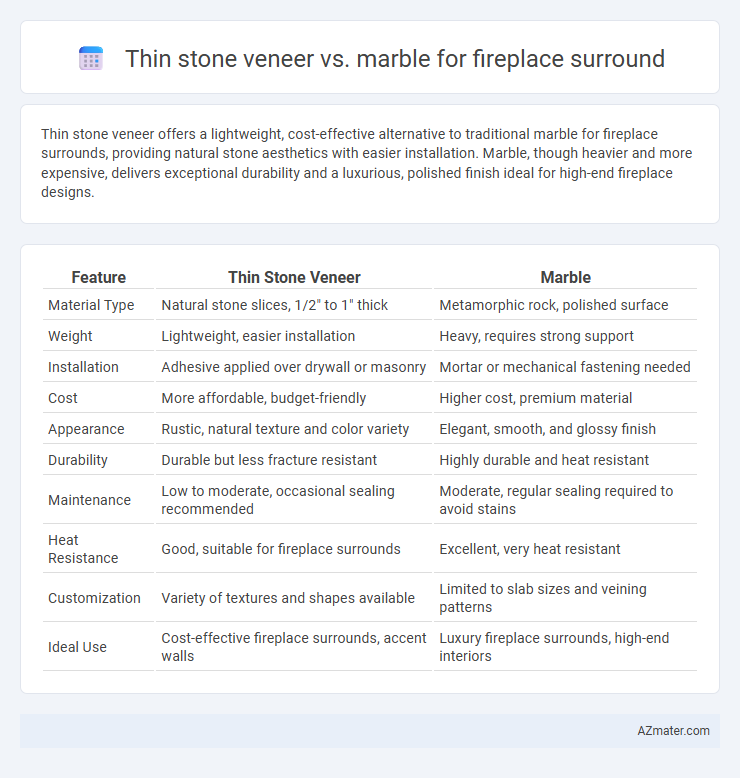Thin stone veneer offers a lightweight, cost-effective alternative to traditional marble for fireplace surrounds, providing natural stone aesthetics with easier installation. Marble, though heavier and more expensive, delivers exceptional durability and a luxurious, polished finish ideal for high-end fireplace designs.
Table of Comparison
| Feature | Thin Stone Veneer | Marble |
|---|---|---|
| Material Type | Natural stone slices, 1/2" to 1" thick | Metamorphic rock, polished surface |
| Weight | Lightweight, easier installation | Heavy, requires strong support |
| Installation | Adhesive applied over drywall or masonry | Mortar or mechanical fastening needed |
| Cost | More affordable, budget-friendly | Higher cost, premium material |
| Appearance | Rustic, natural texture and color variety | Elegant, smooth, and glossy finish |
| Durability | Durable but less fracture resistant | Highly durable and heat resistant |
| Maintenance | Low to moderate, occasional sealing recommended | Moderate, regular sealing required to avoid stains |
| Heat Resistance | Good, suitable for fireplace surrounds | Excellent, very heat resistant |
| Customization | Variety of textures and shapes available | Limited to slab sizes and veining patterns |
| Ideal Use | Cost-effective fireplace surrounds, accent walls | Luxury fireplace surrounds, high-end interiors |
Introduction: Choosing the Right Fireplace Surround
Thin stone veneer offers a lightweight, cost-effective option with natural stone textures that mimic full stone walls without the heavy installation requirements. Marble provides a luxurious, polished appearance with unique veining patterns, ideal for sophisticated fireplace surrounds but demands more maintenance and higher investment. Selecting between thin stone veneer and marble depends on budget, aesthetic preferences, and durability needs for the fireplace design.
Overview of Thin Stone Veneer
Thin stone veneer offers a lightweight, cost-effective alternative to marble for fireplace surrounds, providing the natural look of stone with easier installation and reduced structural load. Composed of real stone cut into thin slices, it maintains authentic texture and durability while allowing for versatile design options. Compared to marble, thin stone veneer often requires less maintenance and resists chipping or cracking, making it ideal for both aesthetic appeal and long-term functionality.
Overview of Marble Fireplace Surrounds
Marble fireplace surrounds offer timeless elegance and superior durability, making them a popular choice for luxury home interiors. Their natural veining and unique color variations provide a sophisticated aesthetic that can enhance the ambiance of any living space. While thin stone veneer is lightweight and easier to install, marble delivers greater heat resistance and long-lasting value for fireplace applications.
Aesthetic Differences: Thin Stone Veneer vs Marble
Thin stone veneer offers a rustic, textured aesthetic with natural variations and a warm, earthy tone that enhances a fireplace surround's organic appeal. Marble provides a sleek, polished look with elegant veining and a high-gloss finish that exudes luxury and timeless sophistication. The choice between thin stone veneer and marble depends on the desired ambiance, whether aiming for a cozy, natural vibe or a refined, upscale appearance.
Durability and Maintenance Comparison
Thin stone veneer offers excellent durability with resistance to chipping and cracking, making it ideal for high-heat fireplace surrounds. Marble, while aesthetically luxurious, is softer and prone to scratches, stains, and etching, requiring regular sealing and careful maintenance. Compared to marble, thin stone veneer demands less upkeep and maintains its structural integrity better in the long term.
Installation Process and Complexity
Thin stone veneer offers a simpler and faster installation process for fireplace surrounds due to its lightweight nature, allowing for easier handling and adhesive application on various surfaces. Marble, being heavier and more brittle, requires professional expertise and specialized tools for cutting, securing, and ensuring precise alignment, increasing the complexity and time of installation. The need for a sturdy substrate and potential for cracking during installation makes marble a more labor-intensive and costly option compared to thin stone veneer.
Cost Analysis: Thin Stone Veneer vs Marble
Thin stone veneer offers a cost-effective alternative to marble for fireplace surrounds, typically priced between $6 and $15 per square foot, whereas marble ranges from $40 to $100 per square foot depending on quality and source. Installation costs for thin stone veneer are generally lower due to its lighter weight and easier handling compared to marble, which requires skilled labor and more structural support. Maintenance expenses also favor thin stone veneer, as marble demands regular sealing and special cleaning products to prevent staining and etching.
Heat Resistance and Safety Considerations
Thin stone veneer offers excellent heat resistance, making it a safe choice for fireplace surrounds as it withstands high temperatures without cracking or discoloration. Marble, while elegant, is less heat-resistant and prone to thermal shock, which can cause cracking or damage when exposed to intense or rapid temperature changes. For maximum safety and durability, thin stone veneer provides a more reliable solution in managing heat exposure around fireplaces.
Environmental Impact and Sustainability
Thin stone veneer offers a significantly lower environmental impact compared to marble for fireplace surrounds due to its reduced material extraction and lighter weight, which lowers transportation emissions. Marble quarrying generates more waste and consumes extensive energy, making it less sustainable than the minimally processed thin stone veneer. Choosing thin stone veneer supports eco-friendly construction by preserving natural resources and reducing carbon footprint in home design projects.
Final Recommendations for Homeowners
Thin stone veneer offers a lightweight, cost-effective solution with easy installation and a natural aesthetic, making it ideal for homeowners seeking budget-friendly fireplace surrounds. Marble provides a luxurious, durable surface with timeless elegance but requires higher investment and professional installation. For homeowners prioritizing affordability and DIY options, thin stone veneer is recommended, while marble suits those desiring premium, long-lasting beauty and are prepared for greater expense.

Infographic: Thin stone veneer vs Marble for Fireplace surround
 azmater.com
azmater.com